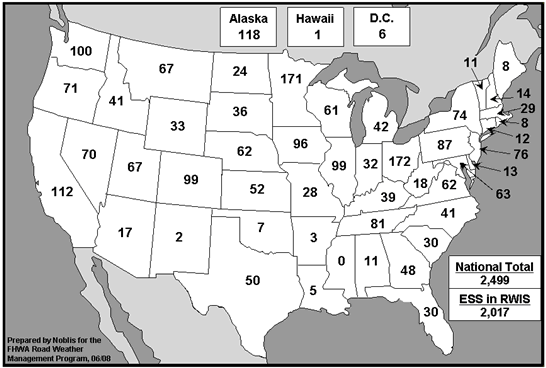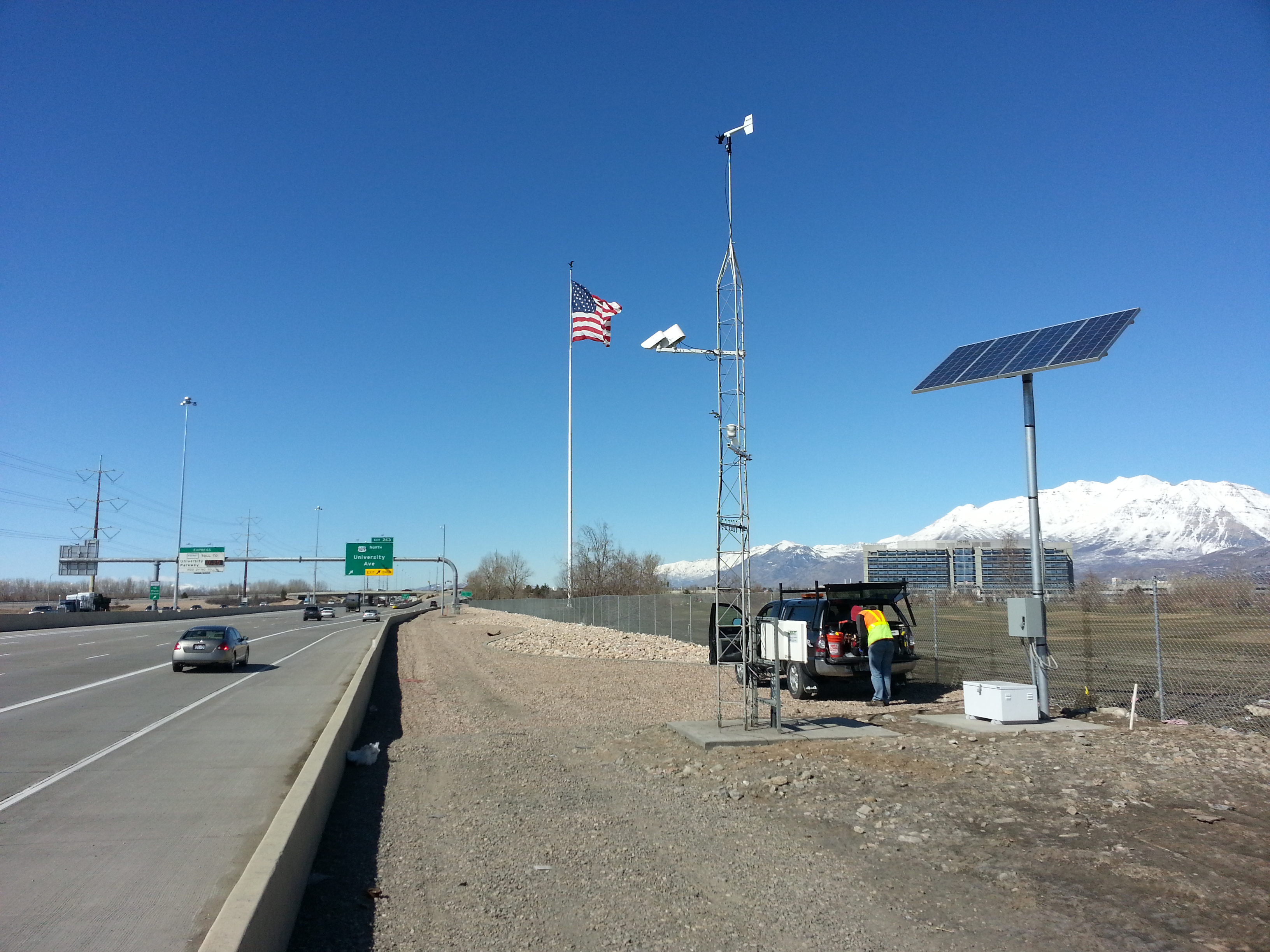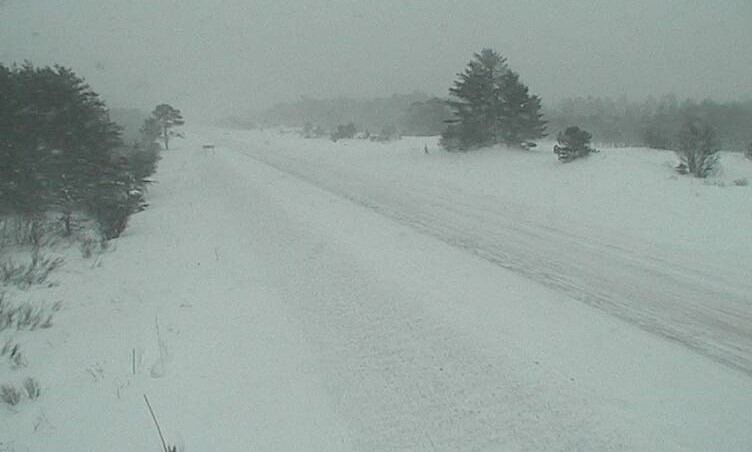Forecasting for the Road Ahead
Special Stories
4 Apr 2019 1:34 AM
[Advanced forecasting techniques can inform drivers about the weather conditions to expect along specific routes. (Image: Public domain)]
[NCAR] Adverse weather conditions on our roadways are responsible for thousands of deaths and billions of dollars of economic costs every year, a panel of experts said at a congressional briefing on Wednesday. The panelists emphasized the importance of research and new technology to provide drivers with detailed weather forecasts of their specific routes, thereby improving safety and mobility.
Improved forecasts of road conditions are becoming especially important with the emergence of autonomous vehicles, which rely on sensors and other technologies that can be affected by snow, fog, and other types of inclement weather, according to the panel of experts from industry, government, and academia.
"From families trying to get away on vacation to companies moving goods and services, the return on investment is substantial when it comes to improving forecasts for our nation's roadways," said UCAR President Antonio Busalacchi.
 [Environmental Sensor Stations and Road Weather Information Systems (RWIS) across the nation. From the U.S. DOT]
William Mahoney, director of the Research Applications Laboratory at the National Center for Atmospheric Research, said recent advances in forecasting are providing a highly detailed view of pavement conditions. This has saved state transportation departments millions of dollars every year by enabling them to plow and treat winter roads more efficiently.
Researchers now are focusing on networks of roadside sensors, improved computer models, and communication systems – via connected vehicles and infrastructure – to provide motorists with greater situational awareness of road conditions. These networks will become even more important for autonomous vehicles that will have to make rapid adjustments in adverse weather conditions.
"We must be ready to respond to new transportation technologies with improvements in weather research and technology," Mahoney said. "That will require additional investments to assure mobility and safety."
[Environmental Sensor Stations and Road Weather Information Systems (RWIS) across the nation. From the U.S. DOT]
William Mahoney, director of the Research Applications Laboratory at the National Center for Atmospheric Research, said recent advances in forecasting are providing a highly detailed view of pavement conditions. This has saved state transportation departments millions of dollars every year by enabling them to plow and treat winter roads more efficiently.
Researchers now are focusing on networks of roadside sensors, improved computer models, and communication systems – via connected vehicles and infrastructure – to provide motorists with greater situational awareness of road conditions. These networks will become even more important for autonomous vehicles that will have to make rapid adjustments in adverse weather conditions.
"We must be ready to respond to new transportation technologies with improvements in weather research and technology," Mahoney said. "That will require additional investments to assure mobility and safety."
 [Road Weather Information System (RWIS) on I-15 in Provo, UT. From the Utah DOT]
Kathy Ahlenius, a project manager for Winter Research in the Wyoming Department of Transportation, emphasized the importance of building more sensors and other infrastructure along heavily trafficked rural roads, such as portions of Interstate 80 in the Mountain West. This would provide additional information to state officials about road conditions, as well as laying the groundwork for the eventual use of autonomous vehicles.
"Upgrades to infrastructure are necessary," Ahlenius said. "The technology that can benefit us by making roads safer will likely require additional funding. That may be the biggest challenge to full implementation of connected and autonomous vehicles."
Andy Alden, executive director of the I-81 Corridor Coalition at the Virginia Tech Transportation Institute, explained the potential to use motor vehicles for the collection of real-time information about road conditions. Equipped with sensors and with algorithms that can rapidly derive local weather conditions from headlight glare or the use of windshield wipers or antilock brakes, connected vehicles can alert nearby drivers and transportation officials about weather hazards such as fog, cross winds, and ice.
[Road Weather Information System (RWIS) on I-15 in Provo, UT. From the Utah DOT]
Kathy Ahlenius, a project manager for Winter Research in the Wyoming Department of Transportation, emphasized the importance of building more sensors and other infrastructure along heavily trafficked rural roads, such as portions of Interstate 80 in the Mountain West. This would provide additional information to state officials about road conditions, as well as laying the groundwork for the eventual use of autonomous vehicles.
"Upgrades to infrastructure are necessary," Ahlenius said. "The technology that can benefit us by making roads safer will likely require additional funding. That may be the biggest challenge to full implementation of connected and autonomous vehicles."
Andy Alden, executive director of the I-81 Corridor Coalition at the Virginia Tech Transportation Institute, explained the potential to use motor vehicles for the collection of real-time information about road conditions. Equipped with sensors and with algorithms that can rapidly derive local weather conditions from headlight glare or the use of windshield wipers or antilock brakes, connected vehicles can alert nearby drivers and transportation officials about weather hazards such as fog, cross winds, and ice.
 [Breakdown of a tower based roadway sensor. From U.S. DOT]
"Motor vehicles can serve as probes for the collection of weather and road condition data," Alden said. "This will be critical with the deployment of autonomous vehicles that are reliant on cameras, lidar, and other technologies that could be adversely affected in inclement weather."
Urban mobility is also a challenge. John Kwant, vice president of city solutions at Ford Motor Company, highlighted how cities are becoming increasingly crowded, causing more congestion — especially during bad weather, when traffic can become gridlocked.
"The growing number of motor vehicles is really pushing our cities to the limit, and this underscores the need to adopt 21st-century technologies," Kwant said. "We need to look at this problem from a systems level and work toward comprehensive solutions, so we can move goods and people through our cities as freely, safely, and efficiently as possible."
[Breakdown of a tower based roadway sensor. From U.S. DOT]
"Motor vehicles can serve as probes for the collection of weather and road condition data," Alden said. "This will be critical with the deployment of autonomous vehicles that are reliant on cameras, lidar, and other technologies that could be adversely affected in inclement weather."
Urban mobility is also a challenge. John Kwant, vice president of city solutions at Ford Motor Company, highlighted how cities are becoming increasingly crowded, causing more congestion — especially during bad weather, when traffic can become gridlocked.
"The growing number of motor vehicles is really pushing our cities to the limit, and this underscores the need to adopt 21st-century technologies," Kwant said. "We need to look at this problem from a systems level and work toward comprehensive solutions, so we can move goods and people through our cities as freely, safely, and efficiently as possible."
 [M-28 near Seney Rest Area in the Upper Peninsula of Michigan from February 2019. From MDOT webcam]
The panelists agreed that the nation is entering a transportation revolution as new technologies are developed, which makes improved weather forecasts even more critical.
"The highways of the future are going to be different than the highways of the past," Busalacchi said. "Now is the time to invest in research, technology, and infrastructure to ensure the safety of all of us on the roads and to keep our economy growing."
The briefing, "Forecasting the Road Ahead," was sponsored by the University Corporation for Atmospheric Research (UCAR), a nonprofit consortium of 117 colleges and universities focused on research and training in the atmospheric and related Earth system sciences.
Edited for WeatherNation by Meteorologist Mace Michaels
[M-28 near Seney Rest Area in the Upper Peninsula of Michigan from February 2019. From MDOT webcam]
The panelists agreed that the nation is entering a transportation revolution as new technologies are developed, which makes improved weather forecasts even more critical.
"The highways of the future are going to be different than the highways of the past," Busalacchi said. "Now is the time to invest in research, technology, and infrastructure to ensure the safety of all of us on the roads and to keep our economy growing."
The briefing, "Forecasting the Road Ahead," was sponsored by the University Corporation for Atmospheric Research (UCAR), a nonprofit consortium of 117 colleges and universities focused on research and training in the atmospheric and related Earth system sciences.
Edited for WeatherNation by Meteorologist Mace Michaels
 [Environmental Sensor Stations and Road Weather Information Systems (RWIS) across the nation. From the U.S. DOT]
William Mahoney, director of the Research Applications Laboratory at the National Center for Atmospheric Research, said recent advances in forecasting are providing a highly detailed view of pavement conditions. This has saved state transportation departments millions of dollars every year by enabling them to plow and treat winter roads more efficiently.
Researchers now are focusing on networks of roadside sensors, improved computer models, and communication systems – via connected vehicles and infrastructure – to provide motorists with greater situational awareness of road conditions. These networks will become even more important for autonomous vehicles that will have to make rapid adjustments in adverse weather conditions.
"We must be ready to respond to new transportation technologies with improvements in weather research and technology," Mahoney said. "That will require additional investments to assure mobility and safety."
[Environmental Sensor Stations and Road Weather Information Systems (RWIS) across the nation. From the U.S. DOT]
William Mahoney, director of the Research Applications Laboratory at the National Center for Atmospheric Research, said recent advances in forecasting are providing a highly detailed view of pavement conditions. This has saved state transportation departments millions of dollars every year by enabling them to plow and treat winter roads more efficiently.
Researchers now are focusing on networks of roadside sensors, improved computer models, and communication systems – via connected vehicles and infrastructure – to provide motorists with greater situational awareness of road conditions. These networks will become even more important for autonomous vehicles that will have to make rapid adjustments in adverse weather conditions.
"We must be ready to respond to new transportation technologies with improvements in weather research and technology," Mahoney said. "That will require additional investments to assure mobility and safety."
 [Road Weather Information System (RWIS) on I-15 in Provo, UT. From the Utah DOT]
Kathy Ahlenius, a project manager for Winter Research in the Wyoming Department of Transportation, emphasized the importance of building more sensors and other infrastructure along heavily trafficked rural roads, such as portions of Interstate 80 in the Mountain West. This would provide additional information to state officials about road conditions, as well as laying the groundwork for the eventual use of autonomous vehicles.
"Upgrades to infrastructure are necessary," Ahlenius said. "The technology that can benefit us by making roads safer will likely require additional funding. That may be the biggest challenge to full implementation of connected and autonomous vehicles."
Andy Alden, executive director of the I-81 Corridor Coalition at the Virginia Tech Transportation Institute, explained the potential to use motor vehicles for the collection of real-time information about road conditions. Equipped with sensors and with algorithms that can rapidly derive local weather conditions from headlight glare or the use of windshield wipers or antilock brakes, connected vehicles can alert nearby drivers and transportation officials about weather hazards such as fog, cross winds, and ice.
[Road Weather Information System (RWIS) on I-15 in Provo, UT. From the Utah DOT]
Kathy Ahlenius, a project manager for Winter Research in the Wyoming Department of Transportation, emphasized the importance of building more sensors and other infrastructure along heavily trafficked rural roads, such as portions of Interstate 80 in the Mountain West. This would provide additional information to state officials about road conditions, as well as laying the groundwork for the eventual use of autonomous vehicles.
"Upgrades to infrastructure are necessary," Ahlenius said. "The technology that can benefit us by making roads safer will likely require additional funding. That may be the biggest challenge to full implementation of connected and autonomous vehicles."
Andy Alden, executive director of the I-81 Corridor Coalition at the Virginia Tech Transportation Institute, explained the potential to use motor vehicles for the collection of real-time information about road conditions. Equipped with sensors and with algorithms that can rapidly derive local weather conditions from headlight glare or the use of windshield wipers or antilock brakes, connected vehicles can alert nearby drivers and transportation officials about weather hazards such as fog, cross winds, and ice.
 [Breakdown of a tower based roadway sensor. From U.S. DOT]
"Motor vehicles can serve as probes for the collection of weather and road condition data," Alden said. "This will be critical with the deployment of autonomous vehicles that are reliant on cameras, lidar, and other technologies that could be adversely affected in inclement weather."
Urban mobility is also a challenge. John Kwant, vice president of city solutions at Ford Motor Company, highlighted how cities are becoming increasingly crowded, causing more congestion — especially during bad weather, when traffic can become gridlocked.
"The growing number of motor vehicles is really pushing our cities to the limit, and this underscores the need to adopt 21st-century technologies," Kwant said. "We need to look at this problem from a systems level and work toward comprehensive solutions, so we can move goods and people through our cities as freely, safely, and efficiently as possible."
[Breakdown of a tower based roadway sensor. From U.S. DOT]
"Motor vehicles can serve as probes for the collection of weather and road condition data," Alden said. "This will be critical with the deployment of autonomous vehicles that are reliant on cameras, lidar, and other technologies that could be adversely affected in inclement weather."
Urban mobility is also a challenge. John Kwant, vice president of city solutions at Ford Motor Company, highlighted how cities are becoming increasingly crowded, causing more congestion — especially during bad weather, when traffic can become gridlocked.
"The growing number of motor vehicles is really pushing our cities to the limit, and this underscores the need to adopt 21st-century technologies," Kwant said. "We need to look at this problem from a systems level and work toward comprehensive solutions, so we can move goods and people through our cities as freely, safely, and efficiently as possible."
 [M-28 near Seney Rest Area in the Upper Peninsula of Michigan from February 2019. From MDOT webcam]
The panelists agreed that the nation is entering a transportation revolution as new technologies are developed, which makes improved weather forecasts even more critical.
"The highways of the future are going to be different than the highways of the past," Busalacchi said. "Now is the time to invest in research, technology, and infrastructure to ensure the safety of all of us on the roads and to keep our economy growing."
The briefing, "Forecasting the Road Ahead," was sponsored by the University Corporation for Atmospheric Research (UCAR), a nonprofit consortium of 117 colleges and universities focused on research and training in the atmospheric and related Earth system sciences.
Edited for WeatherNation by Meteorologist Mace Michaels
[M-28 near Seney Rest Area in the Upper Peninsula of Michigan from February 2019. From MDOT webcam]
The panelists agreed that the nation is entering a transportation revolution as new technologies are developed, which makes improved weather forecasts even more critical.
"The highways of the future are going to be different than the highways of the past," Busalacchi said. "Now is the time to invest in research, technology, and infrastructure to ensure the safety of all of us on the roads and to keep our economy growing."
The briefing, "Forecasting the Road Ahead," was sponsored by the University Corporation for Atmospheric Research (UCAR), a nonprofit consortium of 117 colleges and universities focused on research and training in the atmospheric and related Earth system sciences.
Edited for WeatherNation by Meteorologist Mace MichaelsAll Weather News
More